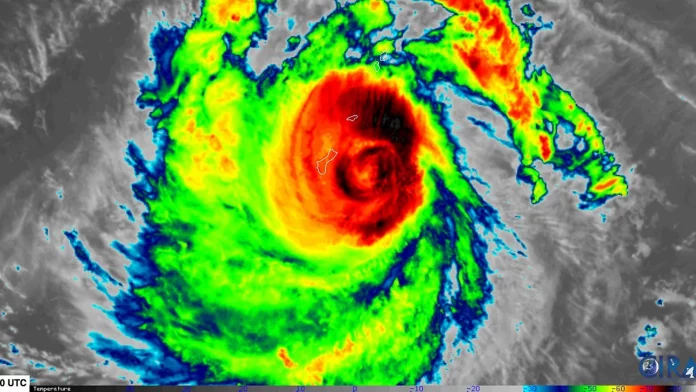Typhoon Mawar was the strongest storm to affect Guam in more than two decades when it struck the Micronesian island in the western Pacific on May 24. More than two weeks later, thousands of people and buildings are still without electricity, including St. John the Divine Episcopal Church and many of its parishioners.
Located in Tamuning, a city between Hagåtña, the capital, and Dededo, the island’s largest city, St. John the Divine is the only Episcopal church in Guam, a U.S. territory of approximately 169,330 people, including nearly 22,000 military personnel. The church experienced severe damages from the typhoon, including broken glass doors, flooding and uprooted vegetation.
The Rev. Irene Maliaman, vicar of St. John the Divine and archdeacon of The Episcopal Church in Micronesia, told Episcopal News Service that it might take weeks for power to be restored at the church because generators are sold out across the island, and it can take two weeks to a month for household goods to ship to Guam from the U.S. mainland.
“Right now, it’s really hot and humid and sticky here in Guam, and there are lots of mosquitos,” she said. “More than anything, it’s the mosquitos that are really keeping me awake at night.”
Maliaman said she’s been staying in St. John the Divine’s vicarage and going to hotels to charge her phone and laptop, as well as to cool down when needed since temperatures have been averaging in the high-80s Fahrenheit lately. Hotels throughout Guam have been booked since the typhoon destroyed many homes and eliminated access to running water and power, according to Maliaman. St. John the Divine also temporarily housed some families throughout the storm and provided them with hot meals and clean water, as well as clean and dry clothes.
Guam is part of The Episcopal Church in Micronesia, a mission area within Province VIII, also known as Province of the Pacific. Hawaiʻi Bishop Robert Fitzpatrick serves as bishop-in-charge of The Episcopal Church in Micronesia, which consists of St. John the Divine and St. Paul’s Episcopal Church in Saipan, the largest island in the Northern Mariana Islands. Fitzpatrick told ENS via email that the Hawaiʻi diocese’s diocesan council sent $10,000 to St. John the Divine, and congregations in Hawaiʻi have also taken special collections to support St. John the Divine, a church home to about 150 Episcopalians.
“Though it is almost 4,000 miles from Hawaiʻi to Guam, there are deep ties between the islands … The Church on Guam is an important part of our Episcopal ʻOhana – family,” Fitzpatrick said.
Maliaman said she is grateful for the donations and awareness spread by Episcopalians in Hawaiʻi, but St. John the Divine will need more money to complete repairs. This week, she submitted an application asking Episcopal Relief & Development for assistance. The church is currently accepting donations via its website, but it’s also continuing to hold worship services and certain events despite its ongoing circumstances in the meantime. Last week, St. John the Divine’s pre-K to 12th grade school held its high school graduation ceremony, albeit in a hotel with electricity.
“It can feel very isolating living on this island, but it’s important to let people know that The Episcopal Church is here in Guam, and it takes a while for us to be able to connect with the wider, physical world church,” Maliaman said. “It’s great to be a part of The Episcopal Church as a family.”



